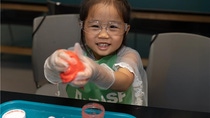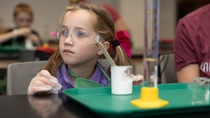Media
Girls in science: STEAM educators weigh in

STEAM (Science, Technology, Engineering, Arts and Mathematics) professionals are key to ensuring America’s innovation and global competitiveness. However, the United States is facing a critical shortage of workers in these fields, which is expected to reach 1.4 million by 2030.
A powerful solution lies in closing the gender gap in STEAM. According to the National Girls Collaborative Project (NGCP), women currently represent 35% of the STEAM workforce in the United States, with Latina, Black, and Indigenous women representing less than 10%. Currently, women earn only 24% of Engineering degrees, 21% of Computer Science degrees, and 24% of Physics degrees.
While this gap has narrowed significantly in the last few decades, there is still a long road ahead to achieve gender equality. To learn more about how we can continue to address and bridge this gap between women and girls in science, read what education specialists in the field have to say about this topic.
Stereotypes and the power of role models
A key part of solving the gender gap in science is starting early. That’s why BASF has partnered with numerous science centers and institutions across North America to provide hands-on learning experiences for students as young as four years old, through engaging programs such as Kids’ Lab.
To gain insight into how we can work together to close this gap, we reached out to some of the educators from these centers:
- Mariam Khella, STEM Educator from Liberty Science Center in New Jersey.
- David Munk, STEAM Educator from the Children’s Museum in Houston, Texas.
- Alexa Fantacone, Sanctuary Director, from the New Jersey Audubon Lorrimer Sanctuary.
When it comes to challenges, Khella and Munk agree that girls often prefer to self-guide and hesitate to ask questions or participate due to fear and low confidence. These feelings are often linked to stereotypes and a lack of female representation in STEAM, leading them to think that science is for boys.
“Representation plays a huge role in breaking down stereotypes and broadening the possibilities of what students believe they can achieve. When young girls see women excelling in STEAM fields, they realize that these areas are not just for boys or people with certain backgrounds—they belong there, too. Seeing women in leadership roles in science sends a powerful message,” Munk explains.
It is my greatest hope that the path I paved for myself will allow other young women to follow in my footsteps and in turn, one day, inspire the youth of the next generation.
For these educators, finding ways to make the classroom equitable is essential to nurturing every child’s natural curiosity. When students feel valued and included, they become eager to explore their questions and learn about topics more thoroughly. Munk notes, “kids work together with amazing energy and enthusiasm, and they can push past those societal expectations.”
On the other hand, Fantacone, an environmental educator who mostly works outdoors, is often surprised by the fact that “little girls are usually more willing to get dirty than the little boys” and how much they enjoy being outside.
Making science accessible
All three experts agree that having the space to connect with science free of judgment or expectations, “where they can build on their ideas and create,” as Fantacone explains, can be a game-changer in sparking interest in STEAM, especially in underserved communities.
Seeing themselves in others, mainly in their local communities and educators, explains Khella, can also help them build confidence. At the same time, Munk says that removing the notion and pressure that girls often feel to be “perfect” can help build their confidence and encourage greater participation.

BASF’s impact on STEAM
The company has long partnered with local and national institutions, including museums, education centers and employee volunteers, to make chemistry more accessible to children and teenagers with the hope to spark their interest in science from a young age.
Since 2010, more than 765,000 youngsters between four and 18 have participated in BASF-sponsored activities across the United States, mainly through Kids’ Labs, where children get a hands-on opportunity to learn about chemistry in a fun and exciting way.
Published on February 19, 2025, by Mariana Licio.
For media inquiries or to repurpose this article, please contact Lisa Brown.
.png)